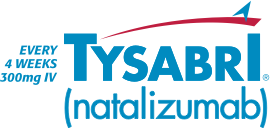DISEASE ACTIVITY EVALUATED IN JCV− PATIENTS STARTING TYSABRI SHORTLY AFTER DIAGNOSIS
4-year results from the study of TYSABRI® (natalizumab) in early relapsing-remitting multiple sclerosis in anti-JCV antibody negative patients (STRIVE)1
Study description: STRIVE was a 4-year, multicenter, observational, open-label, single-arm study conducted in the United States. Patients were anti-JCV antibody negative ≤6 months prior to screening or at baseline and were prescribed TYSABRI 300 mg IV every 4 weeks ≤3 years after RRMS diagnosis.
- NEDA encompassed both clinical (defined as no relapses or 24-week confirmed disability worsening) and MRI (defined as no Gd+ or new/newly enlarging T2 lesions) NEDA
- 155 patients completed the study, whereas 67 withdrew. Of the 155 patients who completed the study, 105 were treated with TYSABRI over the 4 years of the study
- The top reason for natalizumab discontinuation was seroconversion to anti-JCV antibody-positive status/elevated index/PML risk (n=27)
- NEDA analyses used observed data only. Patients with missing data who did not exhibit disease activity on available measurements were excluded, whereas patients with missing data who had evidence of disease activity on ≥1 measurement were considered not to have achieved NEDA. Analyses were conducted in the intent-to-treat (ITT) population, n=222, defined as all enrolled patients who completed informed consent and received ≥1 dose of natalizumab in STRIVE
Study limitations:
- Because STRIVE was an open-label, single-arm study, it lacked an internal comparator group; therefore, placebo effects on the clinical outcomes cannot formally be ruled out. The open-label nature of STRIVE could introduce selection bias in the study population
- Sample sizes were reduced by attrition and missing data, particularly with respect to the NEDA analyses
Likelihood of achieving NEDA in Year 4 was similar whether or not NEDA was achieved in Year 11
NEDA STATUS IN YEAR 4 BY STATUS OF CLINICAL NEDA, MRI NEDA, OR NEDA IN YEAR 1b
bp values are based on unadjusted logistic regression models. Patients with NEDA status available during both the first and fourth years are included.
- In the 4-year STRIVE study, annual NEDA rates ranged from 71.4% to 74.8% in Years 2 through 4
- Annual rates of clinical NEDA (primary endpoint) were consistently >80%
- Safety over 4 years was consistent with the well-established safety profile of natalizumab. No cases of progressive multifocal leukoencephalopathy occurred
The STRIVE study was funded by Biogen.
